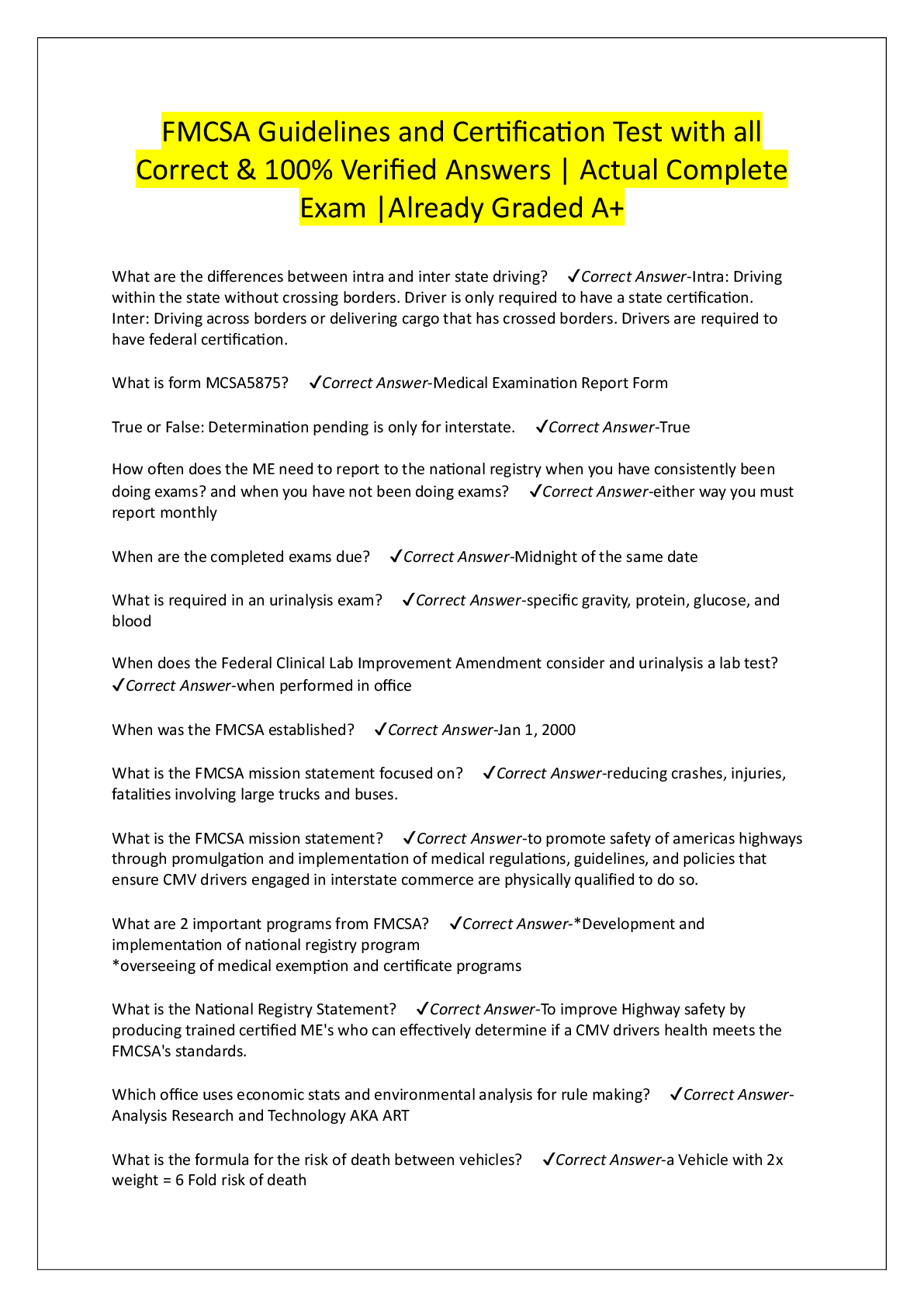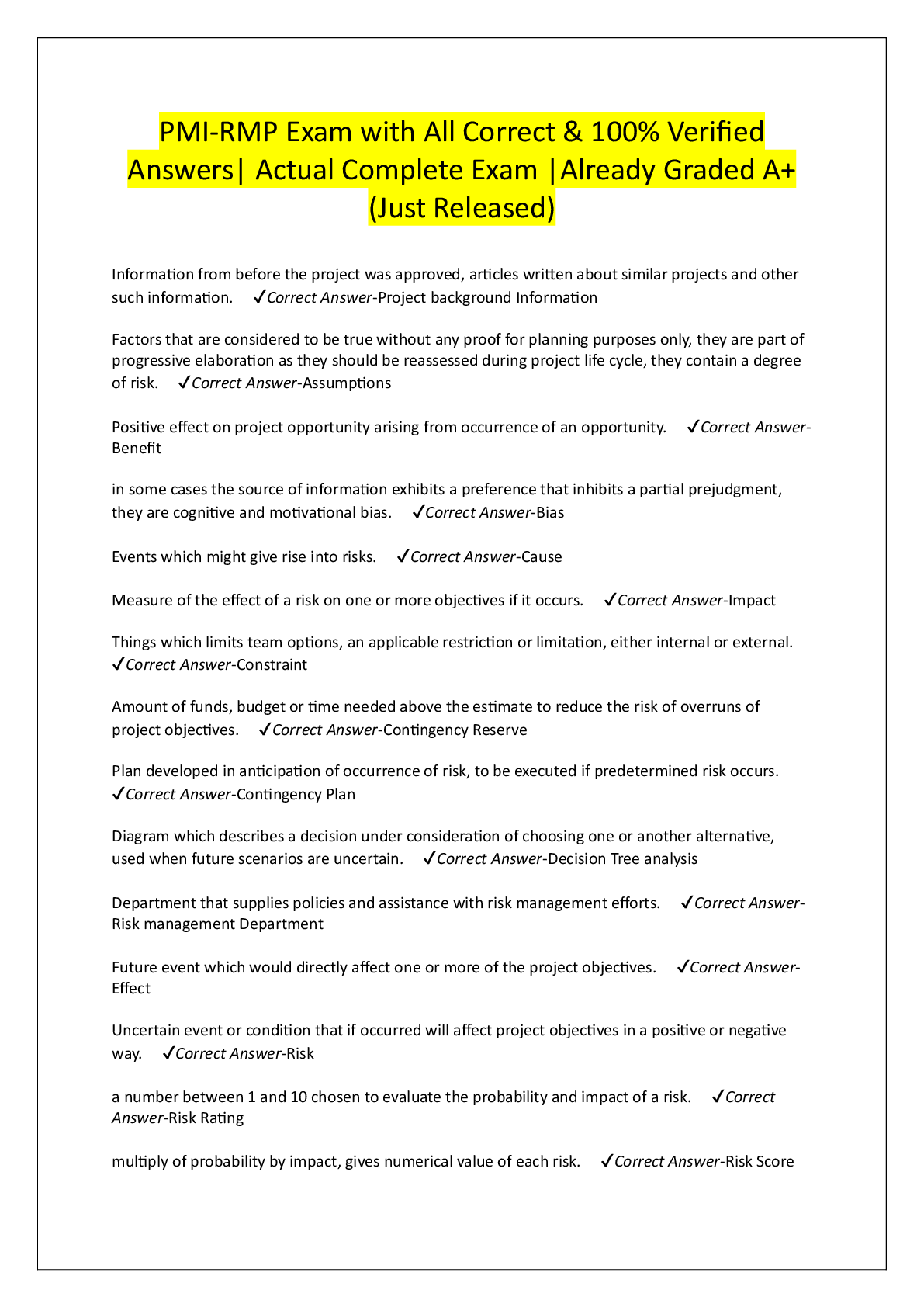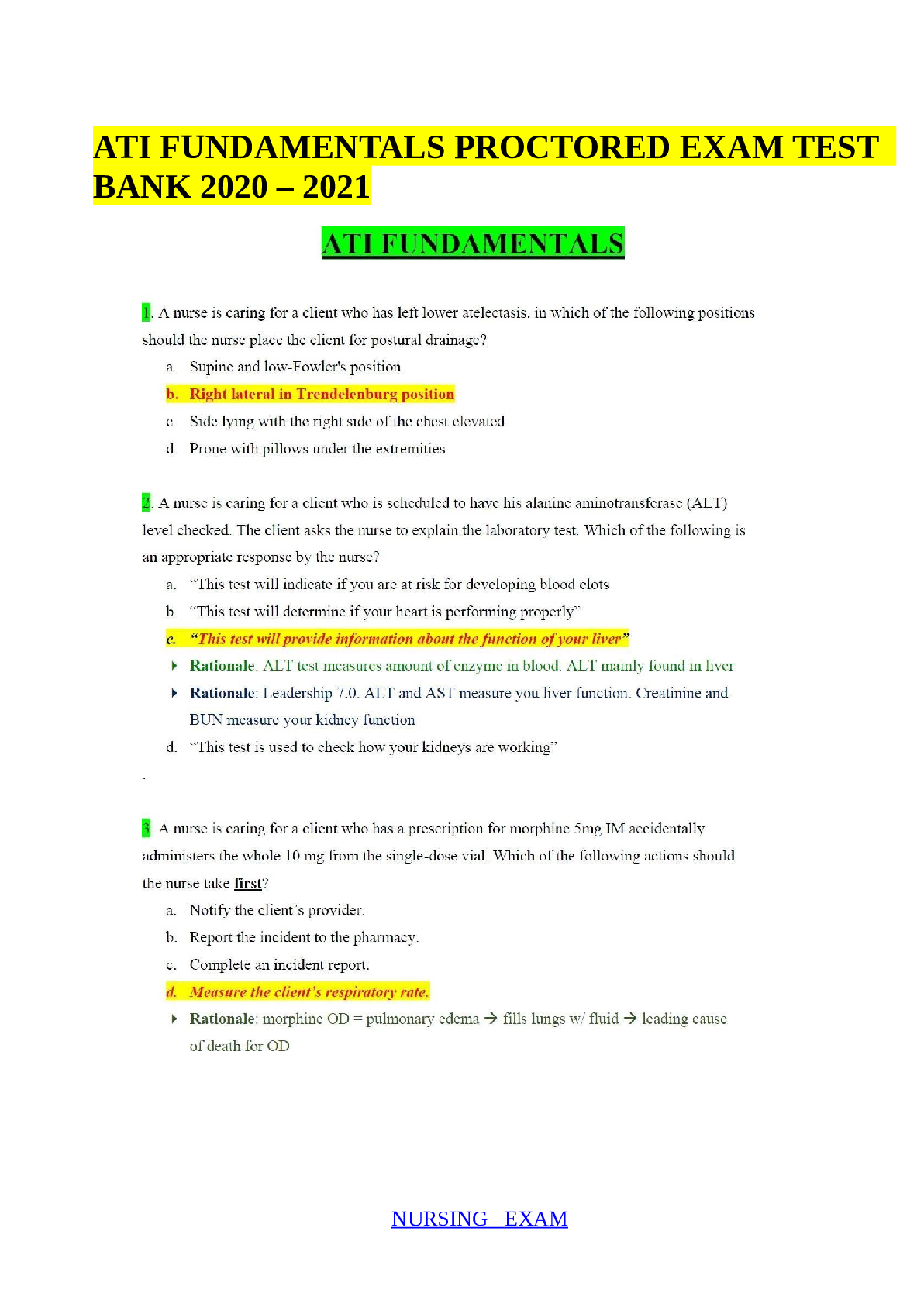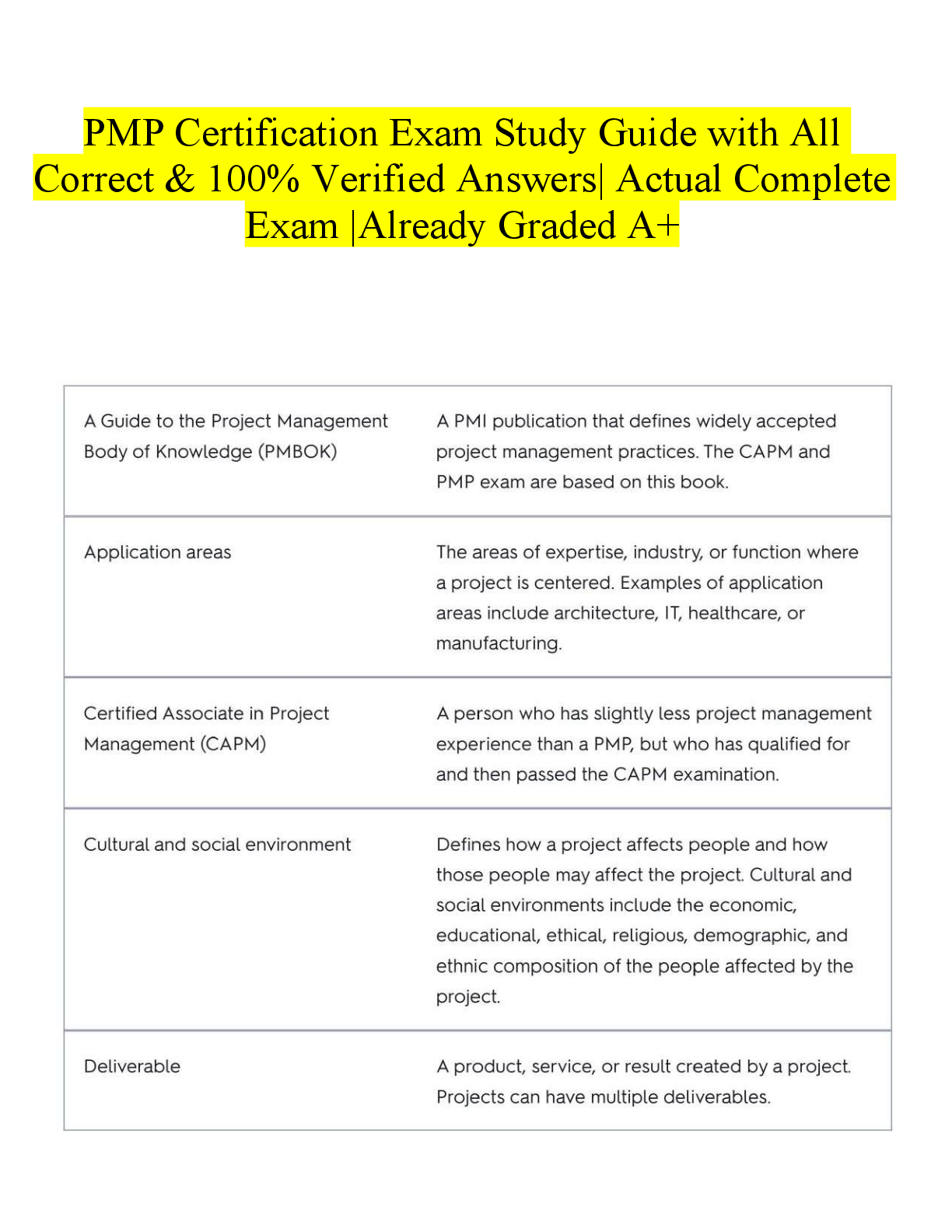NR 509 Week 1 Midweek Comprehension Quiz
Document Content and Description Below
NR 509 Week 1 Midweek Comprehension Quiz Week 1 Midweek Comprehension QUIZ Question 1 2 / 2 pts According to the lesson, part of applying the diagnostic reasoning process requires that ... data be prioritized based on the urgency of the signs or symptoms. Of the following presenting complaints, which is the highest priority? Extreme thirst Acute onset of blurry vision Correct! Shortness of breath Fever of 102 degrees F Part of applying the diagnostic reasoning process requires that data be prioritized based on the urgency of the signs or symptoms. For example, immediate priority must be given to signs or symptoms that reflect life-threatening issues, while other signs and symptoms might be assigned a secondary priority even though they are urgent until the emergent issues are addressed. The lowest level priority issues are those that don't risk life and don't have a high likelihood of escalating in severity. Question 2 1 / 2 pts According to the lesson, there are two types of patient presentations, comprehensive and focused. You will adjust the scope of your history and physical examination to the situation at hand. Which of the following factors influence this decision? (Select all that apply) Correct! The magnitude and severity of the patient's problems The clinical setting—inpatient or outpatient Correct Answer The time available Correct Answer Primary or subspecialty care You will adjust the scope of your history and physical examination to the situation at hand, keeping several factors in mind: the magnitude and severity of the patient's problems; the need for thoroughness; the clinical setting—inpatient or outpatient, primary or subspecialty care; and the time available. Question 3 2 / 2 pts According to the lesson, basic interviewing techniques include active listening and empathetic responses? Correct! True False There are a variety of interviewing techniques that can be effective. Knowing when to apply each technique will result in the most effective responses. These skills require practice. Over time you will learn to select the techniques best suited to the ever-changing dynamics of human behavior in your patient relationships. Key among these techniques are active listening and empathy, the golden links to a therapeutic alliance. Question 4 0 / 2 pts Which of the following data should be included under the general statement with the physical examination findings? Correct Answer Level of distress Heart sounds Chief complaint You Answered Height The general statement is a brief global survey of the patient that usually begins with a one sentence description of the patient's appearance, behavior, demeanor, level of distress, and location in the examination room. Question 5 2 / 2 pts According to the lesson, subjective data is detectable by an observer and can be tested against an acceptable standard? True Correct! False Subjective data is apparent only to person affected; includes client’s perceptions, feelings, thoughts, and expectations. It cannot be directly observed and can be discovered only asking questions. Objective data is detectable by an observer or can be tested against an acceptable standard and includes observation of client behavior, medical records, lab and diagnostic tests, data collected by physical exam. NR 509 WK 1 quiz 2 According to the lesson, basic interviewing techniques include active listening and empathetic responses? Correct! True False There is a variety of interviewing techniques that can be effective. Knowing when to apply each technique will result in the most effective responses. These skills require practice. Over time you will learn to select the techniques best suited to the ever-changing dynamics of human behavior in your patient relationships. Key among these techniques are active listening and empathy, the golden links to a therapeutic alliance. Question 2 2 / 2 pts According to the lesson, subjective data is detectable by an observer and can be tested against an acceptable standard? True Correct! False Subjective data is apparent only to person affected; includes client’s perceptions, feelings, thoughts, and expectations. It cannot be directly observed and can be discovered only asking questions. Objective data is detectable by an observer or can be tested against an acceptable standard and includes observation of client behavior, medical records, lab and diagnostic tests, data collected by physical exam. Question 3 0 / 2 pts Which of the following data should be included under the general statement with the physical examination findings? Correct Answer Level of distress You Answered Heart sounds Chief complaint Height The general statement is a brief global survey of the patient that usually begins with a one sentence description of the patient's appearance, behavior, demeanor, level of distress, and location in the examination room. Question 4 1 / 2 pts According to the lesson, there are two types of patient presentations, comprehensive and focused. You will adjust the scope of your history and physical examination to the situation at hand. Which of the following factors influence this decision? (Select all that apply) Correct Answer The time available Correct! The magnitude and severity of the patient's problems Correct! The clinical setting—inpatient or outpatient Correct Answer Primary or subspecialty care You will adjust the scope of your history and physical examination to the situation at hand, keeping several factors in mind: the magnitude and severity of the patient's problems; the need for thoroughness; the clinical setting—inpatient or outpatient, primary or subspecialty care; and the time available. Question 5 2 / 2 pts According to the lesson, part of applying the diagnostic reasoning process requires that data be prioritized based on the urgency of the signs or symptoms. Of the following presenting complaints, which is the highest priority? Fever of 102 degrees F Extreme thirst Correct! Shortness of breath Acute onset of blurry vision Part of applying the diagnostic reasoning process requires that data be prioritized based on the urgency of the signs or symptoms. For example, immediate priority must be given to signs or symptoms that reflect life-threatening issues, while other signs and symptoms might be assigned a secondary priority even though they are urgent until the emergent issues are addressed. The lowest level priority issues are those that don't risk life and don't have a high likelihood of escalating in severity. Week 1 Quiz 3 1.5 / 2 pts According to the lesson, there are two types of patient presentations, comprehensive and focused. You will adjust the scope of your history and physical examination to the situation at hand. Which of the following factors influence this decision? (Select all that apply) Correct! The magnitude and severity of the patient's problems Correct! The clinical setting—inpatient or outpatient Correct! Primary or subspecialty care Correct Answer The time available You will adjust the scope of your history and physical examination to the situation at hand, keeping several factors in mind: the magnitude and severity of the patient's problems; the need for thoroughness; the clinical setting—inpatient or outpatient, primary or subspecialty care; and the time available. Question 2 2 / 2 pts According to the lesson, subjective data is detectable by an observer and can be tested against an acceptable standard? True Correct! False Subjective data is apparent only to person affected; includes client’s perceptions, feelings, thoughts, and expectations. It cannot be directly observed and can be discovered only asking questions. Objective data is detectable by an observer or can be tested against an acceptable standard and includes observation of client behavior, medical records, lab and diagnostic tests, data collected by physical exam. Question 3 2 / 2 pts According to the lesson, part of applying the diagnostic reasoning process requires that data be prioritized based on the urgency of the signs or symptoms. Of the following presenting complaints, which is the highest priority? Acute onset of blurry vision Extreme thirst Correct! Shortness of breath Fever of 102 degrees F Part of applying the diagnostic reasoning process requires that data be prioritized based on the urgency of the signs or symptoms. For example, immediate priority must be given to signs or symptoms that reflect life-threatening issues, while other signs and symptoms might be assigned a secondary priority even though they are urgent until the emergent issues are addressed. The lowest level priority issues are those that don't risk life and don't have a high likelihood of escalating in severity. Question 4 0 / 2 pts Which of the following data should be included under the general statement with the physical examination findings? Heart sounds Height Correct Answer Level of distress You Answered Chief complaint The general statement is a brief global survey of the patient that usually begins with a one sentence description of the patient's appearance, behavior, demeanor, level of distress, and location in the examination room. Question 5 2 / 2 pts According to the lesson, basic interviewing techniques include active listening and empathetic responses? Correct! True False There are a variety of interviewing techniques that can be effective. Knowing when to apply each technique will result in the most effective responses. These skills require practice. Over time you will learn to select the techniques best suited to the ever-changing dynamics of human behavior in your patient relationships. Key among these techniques are active listening and empathy, the golden links to a therapeutic alliance. Quiz Score: 7.5 out of 10 [Show More]
Last updated: 3 years ago
Preview 1 out of 8 pages

Buy this document to get the full access instantly
Instant Download Access after purchase
Buy NowInstant download
We Accept:

Also available in bundle (1)
Click Below to Access Bundle(s)
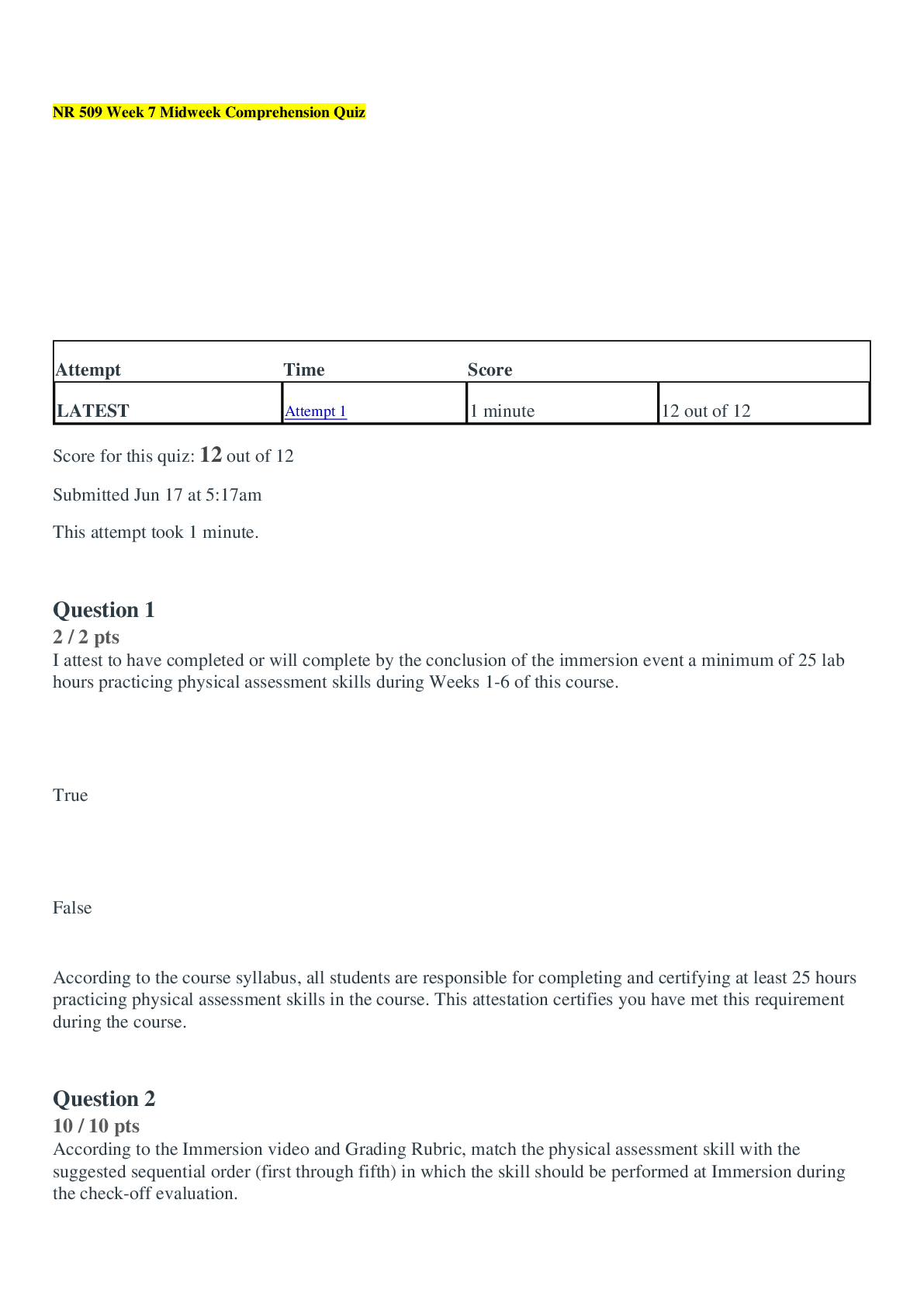
NR 509 Week 1 to Week 7 Midweek Comprehension Quizzes and Answers
NR 509 Week 1 to Week 7 Midweek Comprehension Quizzes and Answers
By YourTutor 4 years ago
$45.5
7
Reviews( 0 )
$13.50
Can't find what you want? Try our AI powered Search
Document information
Connected school, study & course
About the document
Uploaded On
Jan 28, 2021
Number of pages
8
Written in
All
Additional information
This document has been written for:
Uploaded
Jan 28, 2021
Downloads
0
Views
120













